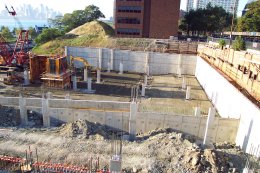
Contractors for Stevens Institute are now pouring the concrete walls, supporting columns and ramps for the four-story parking garage, not yet approved by the Planning Board.
(September 2002)
On Thursday, September 12 at 7 p.m. at Hoboken City Hall, Stevens Institute of Technology will present their “concept” plan for a 725 car parking garage facing Sinatra Park at Hoboken’s waterfront. In March of 2002, without Planning Board approval, Stevens Institute began excavating the serpentine rock at Castle Point to make way for this massive facility. Having finished digging out a cavernous pit about a month ago, Stevens began pouring concrete, including 40 to 50 foot high walls, ramps and support columns for the garage structure. Now, six months after the work began, Stevens is coming before the Hoboken Planning Board seeking approvals.
The Fund for a Better Waterfront (FBW) has promised to mount a legal challenge to this project. According to Ron Hine, FBW’s Executive Director, the garage will require major zoning variances for open space, lot coverage and building length. Hine also stated, “This four-story parking garage will put a bleak face on the waterfront and force all its traffic to spill onto Sinatra Drive intended to be part of a pedestrian-friendly waterfront.” The Hoboken zoning regulations currently prohibit exposed parking facilities and garage entrances facing Sinatra Drive and the waterfront at the south and north ends of town.
On July 16, Planning Board Attorney Douglas Bern wrote to the Hoboken Mayor and City Council asking them to review the permit granted to Stevens for this work. The Planning Board has examined their own files and those of the Hoboken Building Inspector. The Board determined that they had not authorized through their approval process any of this work, excepting the School of Technology Management, also known as the Babbio Center, at Sixth and River Streets with a surface parking lot for 105 cars. Thus far, the Mayor and Council have failed to respond to the Planning Board.
A month after Stevens began the blasting and excavation of the serpentine rock, FBW discovered that the rock contained asbestos. A complaint was filed with the Hoboken Board of Health. Later, FBW found that the contractor was illegally dumping this hazardous material in the Meadowlands in Carlstadt, New Jersey. The New Jersey Meadowlands Commission ordered the contractor to cease and desist the dumping. After a delay of a number of weeks, trucks then began hauling the remainder of an estimated 40,000 cubic yards of contaminated rock to Linden, New Jersey. Tests conducted by the Meadowlands Commission found high levels of asbestos in several samples, including actinolite asbestos, a potent carcinogen. Throughout this operation, Stevens Institute maintained that the rock contained only trace amounts of asbestos and that no health hazard had been posed. Stevens Institute, through one of their attorneys, wrote to a number of foundations that have been providing financial support to FBW threatening to sue FBW for libel regarding the asbestos issue.
FBW has hired Stuart Koenig of Stickel Koenig & Sullivan in Cedar Grove, New Jersey to represent them before the Hoboken Planning Board regarding the garage application. Earlier this year, FBW contracted with their urban planner, Craig Whitaker to draw up plans regarding this area from Fourth to Twelfth Streets along Sinatra Drive. These plans called for a smaller garage enclosed behind academic and research facilities that would provide an opportunity to erect agreeable architecture facing the waterfront. These plans also called for narrowing Sinatra Drive, thus making it more pedestrian friendly and allowing the opportunity to continue the rows of London Plane trees at Hoboken’s south waterfront through Sinatra and Castle Point Parks. And the missing link of the waterfront park would be completed between these two parks on land owned by Stevens Institute of Technology. Both Stevens and the City rejected these proposals.
FBW News Archive
